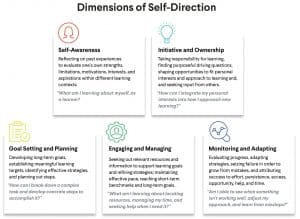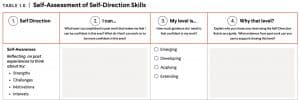Building Habits of Success with the BEST Self-Direction Toolkit
CompetencyWorks Blog
 In competency-based education settings, learning focuses on developing essential skills, dispositions, and mindsets in addition to academic knowledge. These “habits of success” can be learned, but traditional approaches to K-12 education invest minimal effort in helping students develop them. Fortunately a shift is underway, with a growing number of schools, districts, and states acting on their vital role in helping students build habits of success.
In competency-based education settings, learning focuses on developing essential skills, dispositions, and mindsets in addition to academic knowledge. These “habits of success” can be learned, but traditional approaches to K-12 education invest minimal effort in helping students develop them. Fortunately a shift is underway, with a growing number of schools, districts, and states acting on their vital role in helping students build habits of success.
A valuable new tool from the Building Essential Skill Today (BEST) Research-Practice Partnership supports developing and assessing the essential skill of self-direction. This blog post introduces the BEST Self-Direction Toolkit and shares insights from Tony Doucet, one of the toolkit’s developers and a teacher at Souhegan High School, about how it’s used in his classroom and school.
BEST is a collaboration among teachers and school leaders from four New Hampshire districts, the New Hampshire Learning Initiative, the National Center for Innovation in Education (CIE), the New Hampshire Department of Education, KnowledgeWorks, and Jobs for the Future. New Hampshire has been a national leader in advancing practice on essential skills and dispositions, or “work study practices” (WSPs), to use the state’s official term. One of the field’s key resources, the Essential Skills and Dispositions Framework, maps onto New Hampshire’s four WSPs: self-direction, collaboration, communication, and creativity.
Souhegan was an early adopter of deliberate strategies to help students develop habits of success, but before they had the toolkit, Doucet explained, every teacher defined self-direction for themselves. The toolkit helped them share a common definition, which is invaluable for helping students understand what they’re working toward. (This supports another aspect of the definition of competency-based education—that expectations should be explicit and measurable.) The toolkit provides five dimensions of self-direction, defined in the figure below: (1) self-awareness, (2) initiative and ownership, (3) goal setting and planning, (4) engaging and managing, and (5) monitoring and adapting.

Doucet typically selects a subset of these five dimensions to emphasize in particular units or projects. For example, when we spoke, in May, his students were planning their “Proposals to Improve Souhegan” project. Souhegan has a very democratic student government, and students in his 9th-grade social studies class spend the final several weeks of the school year working on something they want to change about the school. The dimension of self-direction they explicitly incorporate into this project is goal setting and planning, because students have lots of independent time during the unit when they need to plan their next steps. Every day students need to develop a goal such as calling the superintendent’s office to set up a meeting or reaching out to other local high schools to see if they already have the policy in place that the students are proposing to adopt at Souhegan.
In Doucet’s experience, it’s better to focus on selected dimensions of self-direction for different projects, rather than the entire construct at once. “All of the five dimensions are big things,” he explained, “and if you try to do all five at once, it’s too much for many students. It’s better to focus on parts of it and get them really thinking about how they are with that particular aspect of self-direction.” Over the course of the year, the students end up focusing on all five dimensions.
The toolkit provides assessment rubrics for all five dimensions of self-direction for each of four age bands—grades K-2, 3-5, 6-8, and 9-12. The rubric for grades 9-12 for three of the dimensions of self-direction is shown below. For example, the lowest level of Initiative and Ownership is “I can choose a new learning opportunity from options provided and explain how it reflects personal curiosity or interests.” The highest level is “I can seek input to help me analyze the content and context of learning tasks in order to reshape, extend, or enhance my own learning.”

Doucet and his students use these rubrics to assess performance tasks that incorporate self-direction. The toolkit provides two detailed tasks for student self-assessment, which is a common approach for assessing growth in habits of success. The first task guides students in reviewing the self-direction rubric for their age band, reflecting on their current use of self-direction, rating their current ability level, and identifying one area of strength to build on and one area to improve. The second task is a “self-direction road map” that students use from the beginning to the end of a given project. The road map guides students through a process of developing an action plan, selecting a self-direction goal to focus on throughout the project, obtaining input from others, revising the plan as needed, reflecting on progress in the middle and end of the project, and sharing evidence of progress and reflections. Both tasks include extensive instructions and graphic organizers for teachers and students, such as the student self-assessment of one of the five component of self-direction shown below.

Souhegan uses standards-based grading on a 1 to 4 scale for both academic standards and work study practices. Each teacher assigns a score for each WSP in each course, and the student’s final grade for the year on each WSP is an average of those course-level scores. Doucet shared that a downside of averaging across courses is that it obscures important variation and doesn’t reflect the student’s highest level of performance.
Some educators, students, and families at Souhegan also felt that if every course grade contained one academic grade and four WSP grades, the WSPs would overshadow the academic grades. Doucet asked, “What’s more important to colleges? The academic content or the WSPs?” The school community decided to average the WSP grades as a way not to “overwhelm” the academic grades. (An alternative approach, used by some schools, is for WSP grades to be based on a body of evidence that students build across all of their courses, rather than having separate WSP grades for each course.)
Teachers at Souhegan vary widely on how they assess work study practices, with some applying the BEST rubrics to students’ performance on projects, some relying heavily on student self-assessments, and some using less nuanced strategies such as assigning a ‘1’ for self-direction for a given day if a student didn’t do their homework. Doucet believes that additional professional learning and calibration of practices across teachers would be valuable to advance WSP instruction and assessment practices and ensure that students develop the habits of success deeply.
Grades on WSPs are reported on Souhegan’s college transcripts, and they remain on a 1 to 4 scale, whereas academic standards are converted to letter grades. This is only for transcripts—students don’t receive letter grades on any of the work handed back to them during high school. Grades on WSPs are not factored into grade point averages, and they don’t influence honor roll designations or eligibility for participation in extracurricular activities.
Doucet says that the BEST Self-Direction Toolkit has improved learning and assessment at Souhegan. During end-of-year exhibitions, he has seen students speaking about self-direction with deeper understanding and showing deeper evidence of their progress and proficiency. He believes that his students are thinking about self-direction more because they are dedicating more time to it and have better tools for developing and reflecting on their self-direction skills. The fact that it’s an integral part of their coursework also shows them that self-direction is valued, and that leads them to value it more.
Learn More
- New Hampshire’s Work Study Practices – A Five-Year Journey to Understand, Share, Scale, Deepen, and Meaningfully Assess These Critical Competencies
- Habits of Mind and Learning New Ways of Learning at Journey Elementary
- Student Thinking Made Visible: Assessing Transferable Skills with Brief Performance Tasks
Eliot Levine is the Aurora Institute’s Research Director and leads CompetencyWorks.